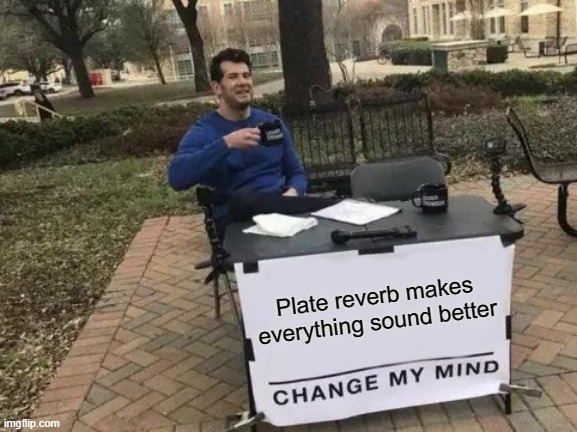Plate reverb has a rich history in the world of audio production, and its distinctive sound has been an integral part of countless iconic recordings. Understanding the origins and technical aspects of plate reverb can provide valuable insight into its application and help producers and musicians make informed choices when using this effect.

History
The concept of using plates to create reverberation dates back to the late 1940s, when pioneering audio engineer Dr. Harold D. Arnold developed the first plate reverb unit at the Echo Lab in Connecticut, United States. This early implementation consisted of a large metal plate suspended in a wooden frame and equipped with a transducer at one end to vibrate the plate. Sound was then captured using pickups placed at strategic points along the plate. By exciting the plate with an audio signal, the vibrations would propagate through the metal, creating a rich and resonant reverb effect.
The use of plates for reverb quickly gained popularity, especially in recording studios where the desire for spacious and immersive soundscapes was paramount. The unique qualities of plate reverb made it particularly well-suited for certain instruments and vocal tracks. In the 1960s, plate reverb became synonymous with the "big" vocal sound, with artists like Frank Sinatra and Roy Orbison utilizing it to give their recordings a luscious and larger-than-life quality.
The process of using a physical plate for reverb has its challenges, primarily due to the large size and delicate nature of the equipment. These units required significant physical space and meticulous maintenance to ensure optimal performance. Over time, advancements in technology led to the development of more compact and reliable plate reverb units, making them more accessible to a wider range of studios and musicians.
Present times
Fast forward to the digital age, and plate reverb has found its place in the realm of virtual effects. Digital plate reverb plugins emulate the sound and characteristics of the physical units, offering flexibility and convenience without the need for a dedicated physical space. These plugins capture the unique resonances and decay patterns of plate reverb and provide various parameters for customization, allowing users to dial in the desired sound.
One notable digital plate reverb effect is the Line6 plate reverb, which is part of their Helix series of products. Line6 has garnered a reputation for delivering high-quality modeled effects, and their plate reverb is no exception. Modeled after the original studio plate reverb, the Line6 plate reverb aims to reproduce the distinct metallic resonances and three-dimensional qualities of its hardware counterparts. It has been praised for its ability to add depth and character to a mix, and its dynamic nature allows for nuanced control over the reverb effect.
When using plate reverb, it's important to consider the context and purpose of the effect. Plate reverb excels at adding brightness, spaciousness, and a sense of depth to recorded tracks. It can work wonders on vocals, drums, and guitars, enhancing their presence and making them stand out in a mix. However, it's crucial to use plate reverb tastefully, as excessive or inappropriate use can overshadow the original sound and make the mix sound artificial.
Plate reverb is particularly effective for melodic instruments, as it can help them cut through the mix without becoming harsh or overpowering. Its ability to create a sense of space and three-dimensionality makes it a valuable tool for adding a natural and immersive quality to recordings. However, caution should be exercised when using plate reverb on bass or low-frequency instruments, as it can muddy up the mix and reduce clarity.
Different genres of music may benefit from different types of reverb, and plate reverb is no exception. While it has a distinctive and desirable sound for many applications, it may not work well in all musical contexts. Genres such as jazz, pop, and classic rock have often embraced plate reverb for its vintage charm and ability to create a warm and enveloping sonic environment. However, in genres where a more realistic or subtle reverb is desired, other types of reverb, such as room or hall, may be preferred.
In conclusion, plate reverb is a timeless and captivating effect that has left an indelible mark on the history of audio production. Its unique sound, characterized by brightness, depth, and a velvety smoothness, has graced countless recordings and continues to captivate listeners today. Whether using physical units or digital emulations, understanding the characteristics and application of plate reverb can empower producers and musicians to harness its power and elevate their music to new heights of excellence.



